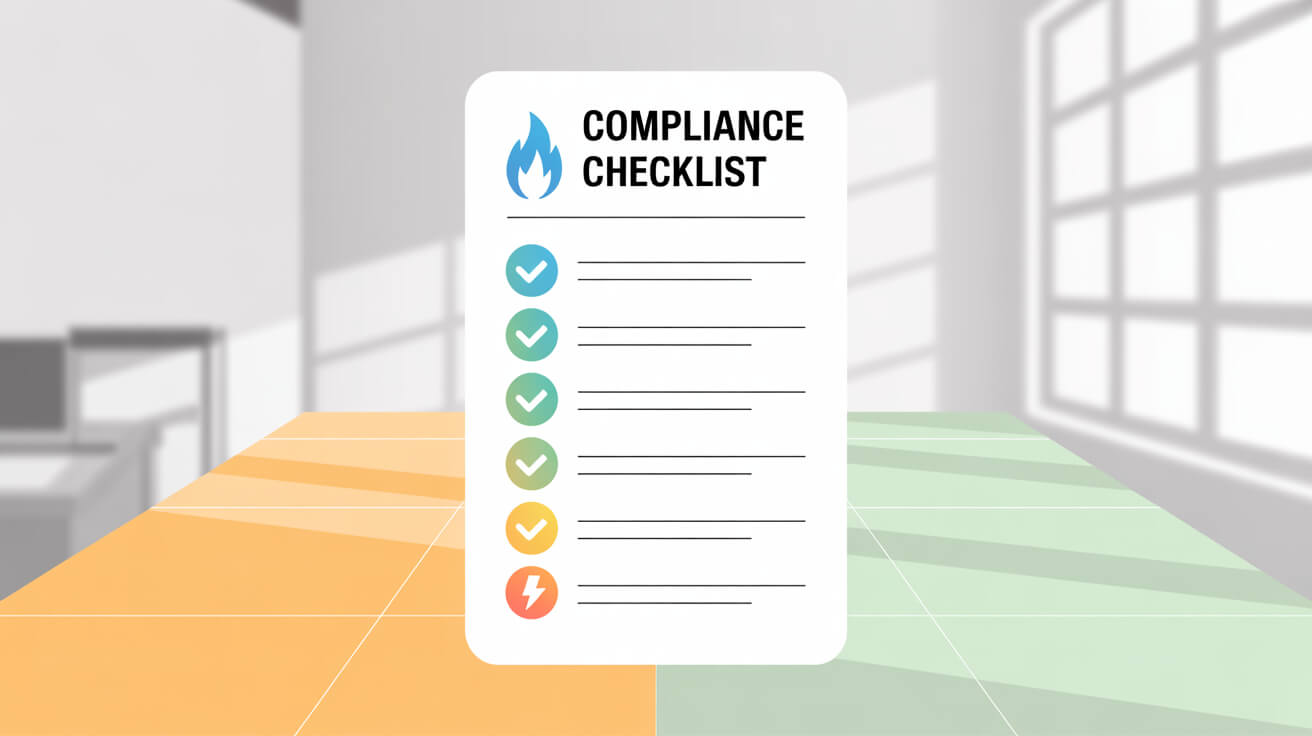 Understanding The 2022 Building Regulation Changes Parts L, F, O, & S
Understanding The 2022 Building Regulation Changes Parts L, F, O, & S

Why Do the 2022 Building Regulation Changes Matter More Than Ever?
Building compliance in the UK has undergone a real transformation. The 2022 regulation changes—Parts L, F, O, and S—aren’t just paperwork updates. They’re the moment the industry pivoted from “box-ticking” to real-time proof, directly impacting asset value, business reputation, and your ability to transact. If you’re still treating compliance as a formality, you’re playing with fire: today, gaps in digital evidence can hold up a sale, freeze letting agreements, or even invalidate insurance.
Every improvement you can’t prove is a risk to your property’s future.
In plain terms: authorities, buyers, and insurers can demand digital compliance evidence at any stage. Relying on “the work’s been done” or a signed job sheet is no longer enough. It’s not just about fines. It’s about liquidity, tenant safety, and proving to the next buyer that your asset is ready for the future—not stuck in the past.
Neglecting these changes is a choice, but delay comes with consequences: delayed transactions, failed insurance checks, and a reputation for corner-cutting. The old “it’ll do” era is gone—compliance is now a non-negotiable, ongoing asset management strategy.
What Are the Must-Know Demands of Part L (Energy Efficiency)?

Owners, landlords, and developers must confront a ramp-up in energy efficiency expectations under Part L. The government’s net-zero commitments are now embedded in building standards—meaning properties must hit precise targets for insulation and thermal performance. Since June 2022, you need to document that every key envelope component—walls, floors, roofs, windows, and doors—meets or beats modern U-value benchmarks.
For context, that’s:
- Walls: ≤ 0.18 W/m²·K
- Floors: ≤ 0.13 W/m²·K
- Roofs: ≤ 0.11 W/m²·K
- Windows/Doors: ≤ 1.2 W/m²·K
Crucially, it’s not enough to instal and walk away. Every refurb, extension, or new build must be backed by a digital SAP (Standard Assessment Procedure) 10.3 assessment. Paper files are obsolete—authorities require digital trails, and so do future buyers.
If you can’t instantly show proof of insulation and SAP scores, your sale or refinance can grind to a halt.
There’s another catch: hiring consultants stuck on old versions or offering “visual-only” sign-off could leave you exposed years later. Lenders, buyers, and letting agents may demand these digital files down the line.
Action Steps for Owners, Landlords, and Developers
- Require digital SAP 10.3 submissions before final payment on every structural project.
- Insist on digital logs for all insulation and envelope upgrades—paper won’t suffice.
- Accept nothing less than the new U-value minima; “grandfathered” standards no longer shield your asset.
- Closely vet contractors for up-to-date compliance knowledge and digital record-keeping.
A missing SAP log is no small oversight—it’s a future liability. Treat every upgrade as a transaction in trust and transparency. That’s the real path to market-ready, insurable property.
What Has Changed in Part F (Ventilation) and Why Does It Matter for Health?

The government is tightening the screws on how air moves through your property. Under Part F, ventilation is no longer just a box to tick—it’s a hard-coded requirement, enforced through digital test logs. Kitchen extractors must achieve ≥ 30 L/s, bath fans between 8–15 L/s, and all commissioning needs to be logged for compliance.
Ignoring these protocols is like leaving your property with the front door unlocked—except the thief is mould, damp, or poor air quality.
The familiar approach—installing a trickle vent and calling it a day—won’t cut it. Properties, especially open-plan or multi-use flats, need mechanical extraction, confirmed via measured performance. No log, no compliance. That’s it.
Why does this matter to owners and facilities managers? Because failures aren’t private anymore. Any damp, mould, or poor air quality complaints post-handover put you under the microscope—and the first demand will be your digital airflow test records.
Essential Checks for Owners and Managers
- Obtain digital commissioning certificates for every extractor installed or upgraded.
- Engage both designers and installers—ensuring ventilation is considered at every stage.
- After upgrades to kitchens or bathrooms, schedule a fresh ventilation test every time.
Skimp now, pay (dearly) later. Fully logged proofs protect not just the building, but your name as an owner or manager. Don’t wait until a sale falls through or a tenant brings a claim—build the trail as you go.
What Does Part O Mean for Overheating Risks in New Properties?

Overheating is not a future issue any more—it’s a regulatory tripwire, thanks to Part O. If you’re involved in new-build housing or major refurbishments, authorities now expect documented, design-stage evidence that you’re actively preventing excessive heat build-up throughout the year.
There’s no loophole; mechanical cooling is a last resort. First, you must design and evidence passive resilience: use north-facing glazing, minimise exposed glass, instal shading, maximise cross-ventilation. Every step and calculation must be justified in advance, ready for review. If you don’t, authorities can—and will—issue notices that delay or block occupation permits (gov.uk).
No owner wants to be in the position of failing to let or sell because overheating calculations or shading diagrams are missing.
The weakest links? South- or west-facing apartments, flats with limited window-opening, or large internal heat gains. Retrofitting these solutions later is high-cost and invasive.
Owners’ and Developers’ Overheating Checklist
- Demand design teams include overheating assessments up front—never as an afterthought.
- Log all calculations, product specs, and visual proofs of passive mitigation.
- When taking handover, get written, digital evidence of compliance for every unit or property.
Treat overheating as a risk to liquidity, not just comfort; future renters and buyers will, because authorities already are.
Why Is Part S (EV Charging) Now Standard—Not an Option?

EV charging is the new normal. If your development or refurbishment includes associated parking, it must either be fully equipped or “EV ready,” with compliant wiring and control gear installed upfront. For homes, that’s at least one 7kW-capable smart charger—tested, documented, certified. For larger sites, 20% of spaces must be fitted chargers, and the rest “EV ready” (gov.uk).
A missing or non-compliant charger is rapidly becoming a deal-breaker for buyers and tenants.
Every charger must pass electrical safety standards (residual-current devices, proper load management), with digital DNO (Distribution Network Operator) sign-off in place before the job is closed. The old “we’ll fit one later” option is not only risky—it forces you into costly retrofits and could void insurance if the instal isn’t certified right first time.
Make Part S Compliance Routine
- Ensure every new property or car space has either a certified charger or full EV infrastructure ready to go.
- Collect all DNO and commissioning certificates in digital format.
- Build EV cert checks into every pre-handover audit—that’s your new baseline, not a “bonus feature.”
If you want to future-proof value and avoid asset freeze on sale or letting, there’s only one answer: certify, document, and store proof as you go.
What Are the Real Deadlines, Fines, and Long-Term Risks of Non-Compliance?

Enforcement has now caught up with the rules. Property professionals face not just stiffer fines, but direct marketplace consequences for missing digital evidence. Lenders, insurers, and local authorities all check for digital records—not paperwork in a file drawer—when reviewing properties.
A missed deadline or missing certificate doesn’t just cost money—it risks the entire transaction going cold.
Here’s how it breaks down:
- For high-rise buildings (11–18 metres), registration is mandatory from March 2025; failure means de-listing or heavy penalties ([gov.uk](https://www.gov.uk/government/publications/amendments-to-approved-document-b-fire-safety-circular-and-letter/approved-document-b-fire-safety-new-updates-to-support-enhanced-fire-safety?utm_source=openai)).
- All fire safety remedials are deadline-bound; finished by 2029, or you risk £1,000+ in escalating fines.
- Every Part L/F/O/S upgrade now requires digital, audit-ready records.
There’s a secondary, but growing, risk: public registers of compliance failures. These notices reach buyers, tenants, and sometimes even the local press—and they stick around, long after fines are paid.
How to Protect Yourself and Your Asset
- Map every project and property status against the current regulation—don’t assume past compliance covers you.
- Store every proof—certificate, commissioning log, test record—in a secure, cloud-accessible format.
- Book pre- and post-project compliance audits with a team fluent in the 2022+ rules.
A defensive stance guarantees you’ll always be reacting. Get proactive: lock in digital compliance evidence, not just physical upgrades, and you’re building on solid ground.
Who Is Now Accountable—And How Can You Secure Your Position?

The compliance chain is now direct—from owner, to manager, to primary contractor, and designer. Liability starts with you and is meant to follow the asset, not the person with the best storey. Insurers, lenders, and future buyers don’t care who was “on the job”—they want to see records, certifications, and audit trails. If these aren’t ready at inspection, you’re bearing the risk, even if “someone else did it.”
Accountability is no longer ambiguous—the digital record is your defence, not the builder’s reputation or a handshake.
For block property managers and portfolio owners, this means designating responsible persons for compliance, with clear, time-stamped evidence for each regulation. For facilities managers, scheduled audits and periodic database checks must be routine—not crisis responses.
Missed or out-of-date records can mean blocked sales, refused insurance, or claims that land in court. If it isn’t documented—and digital—it didn’t happen.
Secure Your Compliance Standing
- Use digital calendar reminders tied to compliance checks, not just works schedules.
- Routinely review and update your approved contractor list; prioritise those offering digital-by-default documentation.
- Store every compliance record in at least two digital locations, ready for instant retrieval during due diligence or emergencies.
Independent compliance health checks separate the best operators from the rest. Don’t just rely on the chain—hold the proof yourself.
How Does All Services 4U Deliver Compliance, Confidence, and Cost-Control?

When you partner with All Services 4U, you’re not just hiring for repairs or upgrades—you’re outsourcing the stress and uncertainty of compliance itself. The team blends hands-on, multi-trade expertise with up-to-the-minute regulatory knowledge. Every project, from SAP upgrades to EV charger instals, is meticulously logged and digitally documented.
Digital logs and photographic records come as standard—not just when asked. Pre-emptive compliance checks spot risks before they grow, so unplanned costs don’t wreck your budget or derail a deal.
The cheapest compliance fix is always the one you never need to redo.
Costs are always transparent, and you’re given advance warning of any regulatory shifts that might affect upcoming works or transactions. All Services 4U prioritises evidence delivery—so if you need a cert to close a deal or respond to an audit, it’s there, not buried in a file or left to chance.
Booking in advance also locks-in stable pricing—a world away from the “emergency rush” premiums that penalise last-minute compliance fixes.
Why the Market Champions All Services 4U
- Regularly refreshed qualifications and compliance retraining.
- Evidence-first approach: instant digital records for every completed task.
- Transparent pricing, flagged risks, and horizon-scanning for future regulation changes.
- Reliable, on-demand audit evidence for insurers, buyers, and property agents.
When asset value, insurability, and reputation are at stake, you want more than a work order—you want defensible proof, delivered as standard.
What Should You Look for in a Building Regulation Health-Check?
A modern property health-check isn’t a checkbox exercise. It’s a serial process, mapped to each major regulation, completed before, during, and after works. Relying on the project manager’s memory or “the last guy’s sign-off” is exposure waiting to happen.
Here’s what every property owner, landlord, or facilities manager should demand:
| Part | Key Focus | Required Proof |
|---|---|---|
| L | Energy Efficiency | SAP 10.3 log, U-values |
| F | Ventilation | Digital flowrate certificates |
| O | Overheating | Shading plans, cooling calculations |
| S | EV Charging | Installation / DNO certs, photos |
Checklist for Real-World Compliance:
- Insulation: Every wall, floor, roof, and window must meet or exceed current standards, digitally logged.
- Ventilation: Every fan must be tested, logged, and certified; skip nothing.
- Overheating: Each new/refurbed unit needs design-led resilience, with calculations and specs logged.
- EV Charging: All parking provision must have either a fitted, tested charger or “ready” wiring certified and recorded.
- Compliance Evidence: Store all documents in a central, digital location accessible by your team.
The biggest compliance risk is falling behind—close audit gaps now, and they stay closed.
Share these routines with every stakeholder. Compliance isn’t “one and done”; it’s the rhythm of modern property operation.
Partner With All Services 4U Today
Modern compliance is continual, not a last step before handover. All Services 4U is the ally that property owners, landlords, and facilities managers need—guiding you from first audit to completed works, and keeping your asset ready for every inspection or inquiry.
Compliance moves fast. So do we. Secure your asset, your time, and your reputation today by partnering with professionals who treat every standard as a line in the sand—not a moving target.
When you’re ready for every audit and transaction before the question’s even asked, you’re not just compliant—you’re in control.
Frequently Asked Questions
Who falls under the 2022 Building Regulations—and how do you pinpoint if your property is truly compliant?
The 2022 updates to UK Building Regulations reach farther than many property stakeholders realise: anyone who owns, manages, or upgrades a building—from a single flat to a commercial block—is directly in scope. Any significant change to structure, systems, or use (including boiler swaps, window upgrades, or creating new living spaces) may require compliance with stringent safety, energy, and documentation thresholds. Properties in the 11–18 metre bracket, converting use, or with communal areas face extra scrutiny—nobody is safely “grandfathered in”.
Ignore fresh obligations and you’re courting registration delays, future transaction blocks, or even insurance complications. Landlords, facilities operators, and leaseholders bear additional duties around fire safety and accessibility. Routine works that once slipped through now leave a digital paper trail—each project adds to your compliance record, visible to buyers, lenders, and authorities.
Every property leaves a digital footprint—if your compliance path isn’t clear, missed steps will show in future deals.
Which refurbishment triggers force a compliance overhaul?
- Major upgrades: Any change to structural walls, roofs, heating, or electrics.
- Converted or extended use: Adding rooms, business areas, or converting commercial-to-residential.
- Communal areas: New or altered corridors, lobbies, fire doors.
- Portfolio sales: Multiple addresses are checked together, raising exposure to missed prior compliance.
Does “just a quick upgrade” mean I’m exempt?
Even minor upgrades, such as replacing doors or adding insulation, often demand compliance checks and digital documentation. Many property managers underestimate the risk until they’re asked for proof at refinancing or sale.
Where should you start?
Map your asset and planned works with a property compliance audit via a seasoned all-trade provider like All Services 4U—before regulatory or transactional deadlines impose costly surprises.
What standards and evidence are now essential for insulation and heating compliance under Part L?
Part L in 2022 turned every insulation and heating decision into a carbon-counted, digitally tracked operation. If you’re upgrading walls, roofs, boilers or windows, current projects must demonstrate a 31% carbon reduction versus previous standards. Miss the new U-value cutoffs (≤ 0.18 W/m²·K for most walls) or fail to maintain a full digital record and your project falters—not just on completion, but for every future lender, insurer, or buyer.
The era of “good enough” insulation is over. Photographic proof, SAP 10.3 calculations, and evidence at each build stage are non-negotiable. Withhold or misplace that file and you don’t just get snagged by building control—you could see deals stall, insurance lapse, or rental income freeze until the trail is restored.
Today, compliance is 90% documentation and only 10% installation—miss the record, lose the result.
Which documents must I hold—at what stage?
- SAP 10.3 calculations: Before, during, and post-build or installation.
- U-value certificates: For walls, windows, floors, and roofs.
- Stage-by-stage photos: Key milestones (insulation fitted, before walls close, final finish).
- Digital handover pack: For each upgrade—a requirement for refinancing or sale.
Is retrospective compliance possible if proof is missing?
You can open walls or commission expensive postworks to retrieve data, but it’s costlier and risks unresolvable gaps in your building’s compliance history.
Steps to pass every audit
Commission installation teams who log digital documentation natively and provide continuous compliance oversight—something All Services 4U offers as standard, reducing the risk of a single missed step.
How do the new Parts F and O transform ventilation, overheating controls, and inspection protocols?
Parts F and O recast ventilation and overheating measures as legal priorities, not afterthoughts. Owners and managers must prove precise airflow rates in kitchens (≥ 30 L/s), bathrooms (≥ 8–15 L/s), and all habitable spaces, with digital commissioning files that can be called up at inspection, sale, or audit. Overheating compliance—vital for south-facing flats, glass-heavy spaces, and any high-occupancy plan—is now checked through calculations and passive cooling strategies at both design and signoff.
Old-school “compliance by statement” dies here. Every missed certificate, or gap in digital proofs, moves your building higher in regulator scrutiny. This isn’t theoretical: failed ventilation tests or missing overheating risk assessments can delay occupancy permits and trigger costly remedial works long after project finish.
Missing one airflow test can hold up an entire handover—compliance is proven, not promised.
What new documents and steps are mandatory?
- Ventilation commissioning certificates: Digital, device-specific records, not generic signoffs.
- Overheating mitigation proofs: Pre-build calculations, shading plans, and after-instal evidence.
- Archival obligations: Keep every digital file for the property’s lifespan, ready for unannounced audits.
Who is responsible for oversight?
The property owner or responsible person—not contractors—is ultimately liable for missing documents, meaning proactive control is essential.
Achieve airtight compliance without last-minute panic
Choose service partners like All Services 4U who integrate digital archiving and documentation generation at every step, making every audit or transaction seamless.
What are the new legal musts for EV charging points and how do you guarantee Part S compliance?
Gone are the days when a “future-ready” duct or lone wall socket met electric vehicle (EV) requirements. Part S now means new builds and qualifying major upgrades must have an operational 7kW charger in every eligible space, plus at least 20% of larger blocks’ bays commissioned now (and ducted for the rest). DIY instals, patchwork signoffs, or generic “ready” statements won’t pass a property audit.
Mortgage approvals, insurance renewals, and building warranty triggers now look for Distribution Network Operator (DNO) signoff, certified installation docs, and digital asset records. Without these, property deals can freeze or entire multi-unit projects lose salability. The clock doesn’t stop: retrofitting compliance after-the-fact is slower, pricier, and risks voiding the work you already paid for.
Resale and re-mortgaging depend on DNO and digital documentation—not a ‘ready for later’ badge.
How can you secure every approval?
- Only use approved installers: Registered, Part S-audited teams produce certifiable digital records.
- Demand DNO signoff at installation: Not after project completion.
- Audit and archive instantly: Keep digital and physical proofs paired to the property address.
- Connect every infrastructure piece now: Empty ducts or written promises won’t be accepted by lenders or sale registries.
How All Services 4U closes your compliance loop
We bring together installation, DNO liaison, and the full digital evidence chain under one service umbrella, eliminating risk gaps and smoothing every audit or future transfer.
What financial and legal risks arise if you ignore or delay compliance obligations?
Failure to meet the 2022 Building Regulations brings more than a slap on the wrist—public compliance registers, escalating fines (from £1,000 up to £25,000+), and insurability barriers crop up fast, especially for high-rise, rental, and portfolio properties. Non-compliance is no longer hidden: digital records flag your asset, impacting its value the minute a buyer, tenant, or bank checks registry data.
Each missed document, outdated record, or absent fire check now echoes through every valuation, letting, or financing process. Persistent offenders may be excluded from sector-wide registers, freezing entire buildings’ transactional status until every audit gap is closed—often at triple the original compliance cost.
One missing logbook entry or expired certificate can cost more than the upgrade itself.
Real penalties for non-compliance
- Failed completions and delayed sales: Buyers and lenders stall at missing digital proofs.
- Public registry “red flags”: Exposure that depreciates your asset portfolio’s value.
- Insurance refusal or retraction: Most providers now verify audit chains before binding cover.
- Forced upgrades under urgent timelines: Costlier, more disruptive, and with reputational fallout.
How can you protect against these risks before they escalate?
Initiate a digital compliance review before scheduled transactions or handovers. Enlist a specialist like All Services 4U for gap-mapping and urgent rectification—closing every compliance loop from major upgrade to paper trail collation.
How does All Services 4U deliver stress-free compliance and keep future value unlocked?
All Services 4U is built for owners and managers who need immediate, compliant, and long-term solutions. Our multi-trade teams carry out every job—boilers, EV charging, insulation, fire safety—while building your property’s digital compliance record as they go. We lock in insurance-ready certificates, real-time SAP and U-value proofs, and comprehensive risk mapping from project launch to digital handover.
That means you never chase forms or scramble at audit. Our systems track fresh regulations, register every milestone, and deliver a secure record for buyers, lenders, and authorities. You see up-front costs, milestone progress, and get frictionless transition between upgrades, documentation, and repeat projects.
The strongest assets on the market have bulletproof compliance records—built by specialists, not patched together at the last minute.
What sets All Services 4U’s process apart?
- Multi-skilled, future-proofing teams: Keep every compliance angle handled in real time.
- Digital-first project logs: No more lost paperwork or failed audits.
- Full-lifecycle management: From pre-project assessment to safe re-mortgaging or sale.
- Transparent pricing and milestone guarantees: Guard your property’s value now and as regulations evolve.
Take the next step with complete confidence
Book a compliance risk review and secure your asset’s future—so every deal, audit, and insurer sees you as a leader, not a straggler. Partnering with All Services 4U is the difference between closing fast and chasing paperwork when it costs the most.



